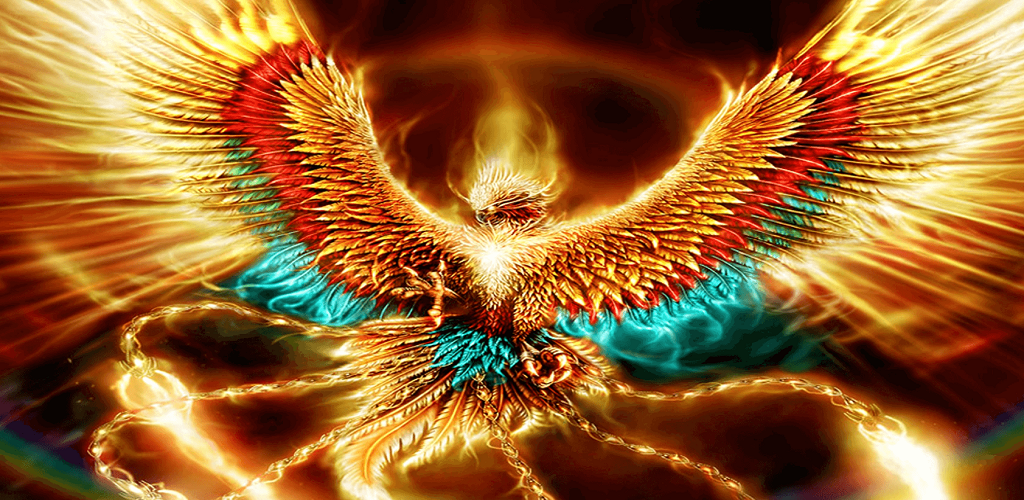
The Constellations
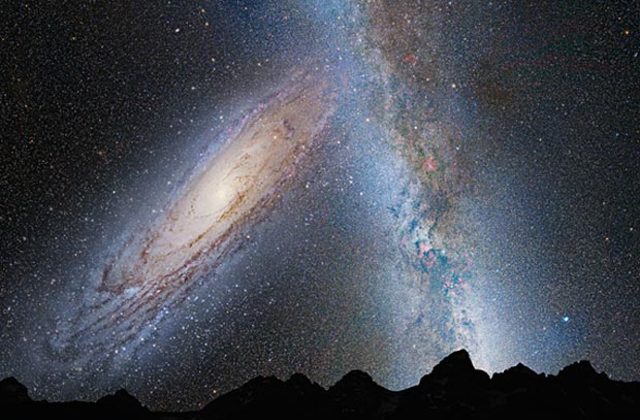
READ MORE HERE:
THE MILKY WAY
THE SIGNS OF THE GREEK ZODIAC
The constellations based on Ancient Greek Mythology...
ANDROMEDA

The constellation Andromeda is named for the Aethiopian princess of the same name. Andromeda was a daughter of Cepheus and Cassiopeia, who was chained to a rock as a sacrifice to the monster Cetus, before being rescued by Perseus, before Andromeda became the wife of the Greek hero.
The mythology of Andromeda also sees the constellation referred to as the Chained Maiden, Cepheis, meaning daughter of Cepheus, and Persea, meaning the wife of Perseus.
Neighbouring constellations to Andromeda include Cassiopeia, Cepheus, Cetus and Perseus, all related to the myth of Andromeda.
AQUARIUS - THE WATER CARRIER
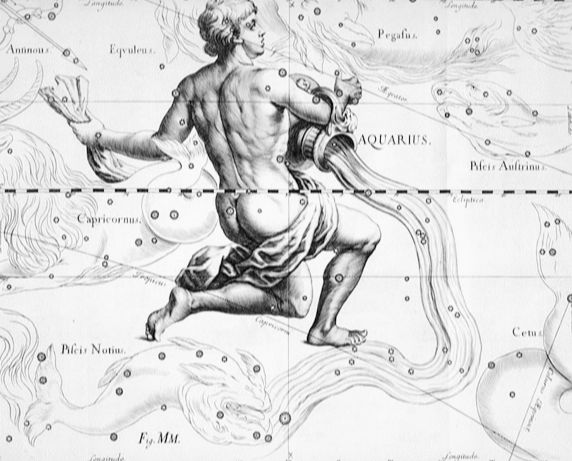
Aquarius is one of the most famous of the ancient constellations as it is also a sign of the Zodiac, although there are several different Greek myths used to explain its existence.
The most famous Greek myth associated with the constellation Aquarius is the tale of Ganymede, the Trojan prince abducted by the eagle of Zeus, to become the god’s lover, and also the cupbearer of the gods. The nearby Aquilla constellation representing the abducting eagle.
Alternatively Aquarius might represent Deucalion, the son of Prometheus, who survived the Deluge; Cecrops I, the king of Athens when wine was discovered, and the man who ensured wine was sacrificed to the gods rather than water; or Aquarius might be the Potamoi Nileus from whom the great waters of the Nile emerged.
AQUILA - THE EAGLE

The name of the constellation Aquila means eagle, and it is most common to suggest that this is the representation of the eagle of Zeus, the bird who abducted Ganymede and also carried the weapons of the god; hence it’s near location to Aquarius.
There were other eagles in Greek mythology though, for an eagle would pluck out the liver of Prometheus as part of his daily torture; Aphrodite was said to have taken the shape of an eagle to act the part of chaser of the swan that was Zeus during the seduction of Nemesis or Leda; and the King of Cos, Meropes, was transformed into an eagle by Hera, as the king was about to commit suicide.
All these eagles have been suggested as the origin of the constellation Aquila.
ARA - THE ALTAR

The constellation Ara is normally associated with the altar first used by the Olympian gods as offerings were made and alliance formed before the Titanomachy.
Alternatively Ara, as the altar, was the representation of the altar of King Lycaon on which he sacrificed his own son, before serving the corpse up as part of the banquet for assembled gods.
ARGO NAVIS - THE ARGO
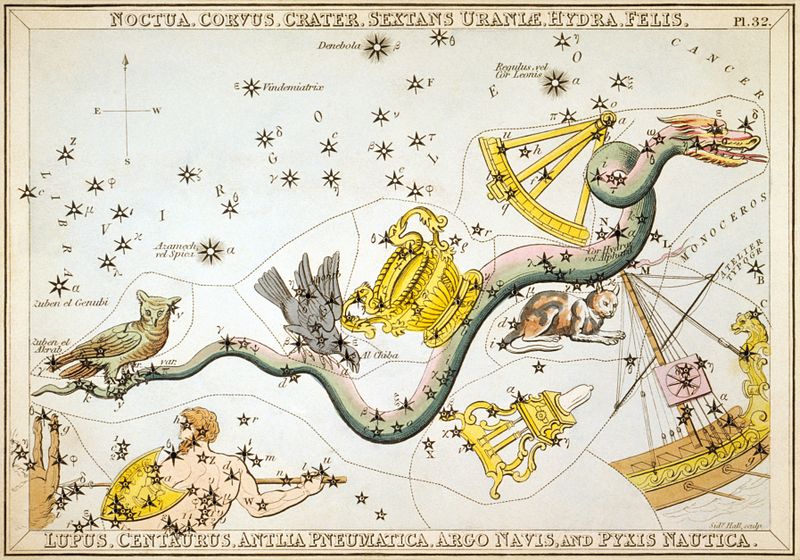
Argo Navis, literally the Ship Argo, represents the vessel that transported Jason and the Argonauts to and from Colchis, as the quest for the Golden Fleece was undertaken.
The Argo was constructed by Argos, from a design of Athena, and was partially made with magical wood from Dodona. The Argo would successful navigate to and from Colchis, encountering, and surviving, many dangers on the voyage. After successfully returning to Iolcus, the Argo was consecrated to Poseidon, and its likeness placed amongst the stars, although the hulk of the ship rotted away.
ARIES - THE RAM
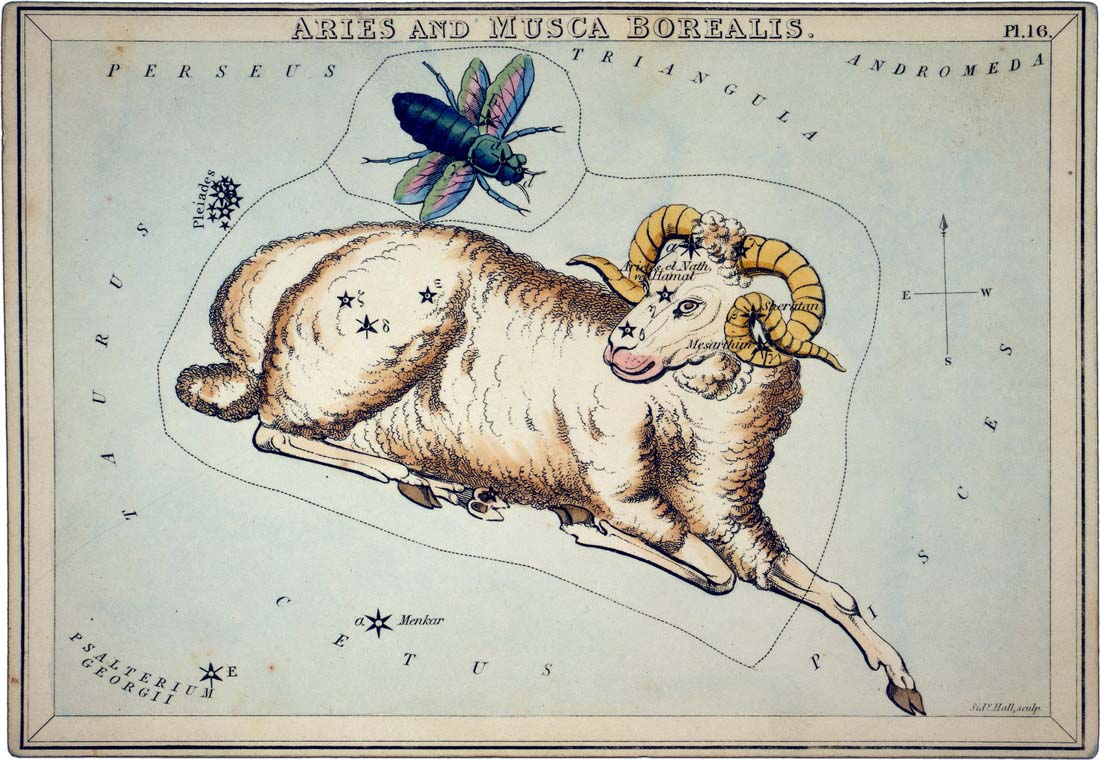
Aries, the Ram, is one of the most famous constellations from antiquity, being as it is, also a sign of the zodiac. Aries is generally considered to be the representation of Crius Chrysomallus, the Golden Ram that rescued Phrixos and Helle from harm at the hands of Ino, and started to fly them to Colchis. Only Phrixos would make it safely to Colchis, and the golden ram told the young boy to sacrifice his rescuer, a sacrifice that gave up the Golden Fleece of mythological fame.
Occasionally it is said that Aries was actually the Ram of Ammon, who appeared and guided Dionysus to a source of water when the god was leading his army, which was dying of thirst.
AURIGA - THE CHARIOTEER
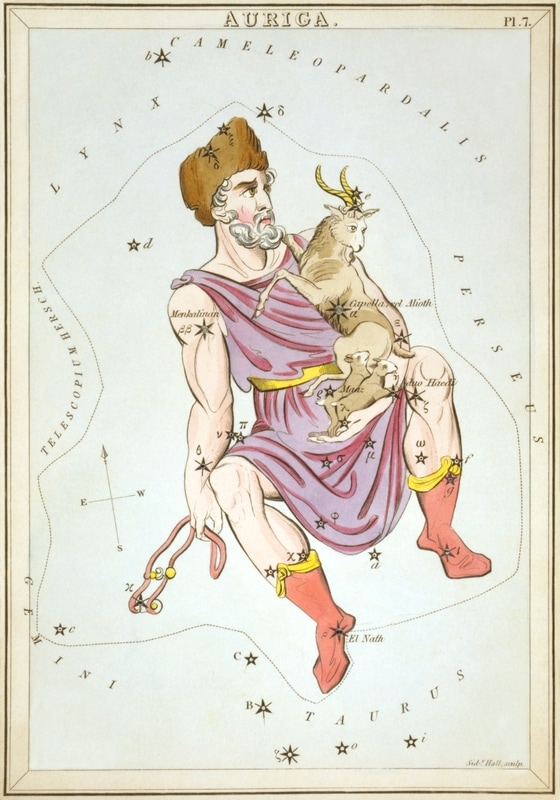
Auriga is the Charioteer constellation, and in Greek mythology various stories are told of who the charioteer is meant to represent.
One possibility is Erichthonius of Athens, a king born of the earth when Athena rejected the advances of Hephaestus. King Erichthonius was credited with inventing the quadriga, the four horse chariot.
Alternatively, Auriga could be said to represent Myrtilus the charioteer of King Oenomaus, who died at the hands of Pelops, after the son of Tantalus had won the hand of Hippodamia; Or else it was Hippolytus, the son of Theseus, who was killed in a chariot accident; or it is Orsilochus a man from Argos who was said to have invented the chariot.
Depictions of Auriga often see the man in a shepherd role holding a goat in his arms. This goat was called the constellation Capra, and was said to represent Amalthea (or Amalthea’s goat), which suckled Zeus, Aex Pan, the goat wife of Pan, or Aex Helios, the goat whose skin became Zeus’ shield.
BOOTES - THE HERDSMAN
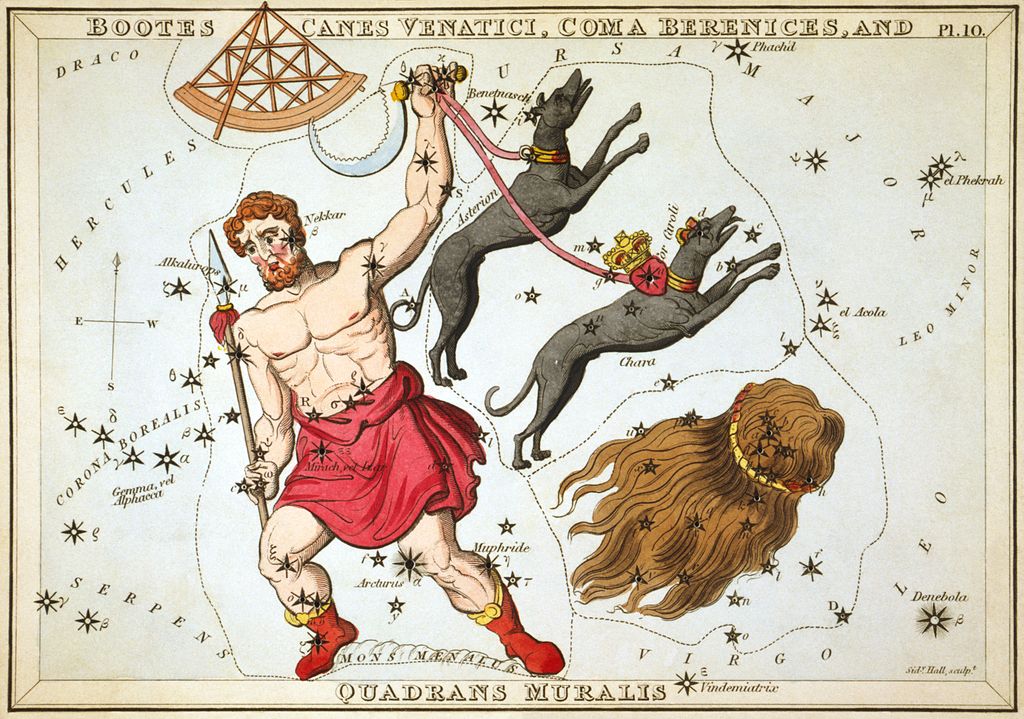
Bootes is a name normally translated as Ploughman, and the ploughman in question is normally considered to be Philomenus, a son of the goddess Demeter, who was the benefactor of man for he invented the plough.
Alternatively, Bootes might be the representation of Icarius, a man blessed by the god Dionysus. Icarius would thereafter make the most intoxicating of all wine. When some people partook of the wine, others believed that they had been killed, and so Icarius himself was killed, with his daughter, Erigone, and dog Maera, subsequently committing suicide. Dionysus would place Icarius amongst the stars, with Erigone becoming Virgo and Maera becoming Canis Major (or Minor).
A third story tells of Bootes being neither a ploughman nor a winemaker, but was instead Arcas, a son of Zeus and Callisto. This is because Bootes is also known as Arctophylax, the bear watcher; for Bootes watches over Callisto in the form of Ursa Major.
CANCER - THE CRAB
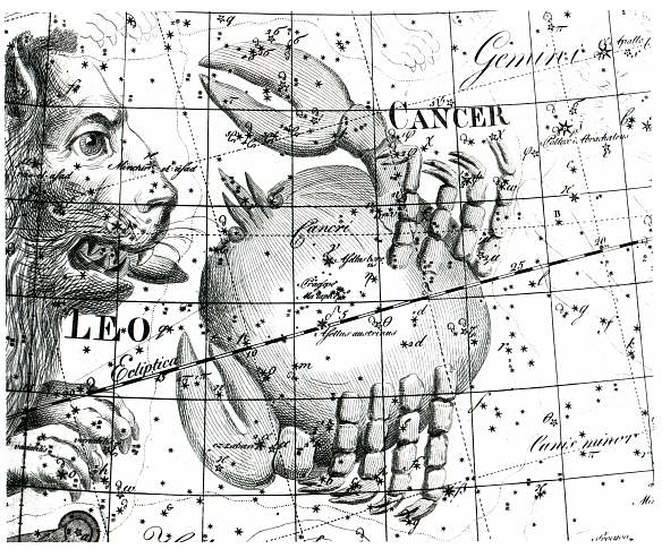
The constellation Cancer is the representation of the monstrous crab Carcinus in Greek mythology. Carcinus was a gigantic crab dispatched by the goddess Hera to battle and distract Heracles as the Greek hero fought with the Lernaean Hydra.
Carcinus was no match for Heracles, and the crab was crushed under the foot of the hero. In recognition of its attempt to kill Heracles, Hera would place the crab amongst the stars.
CANIS MAJOR - THE GREATER DOG

The constellation Canis Major, the greater dog, is normally associated with Laelaps the mythical dog which was always destined to catch its prey. Laelaps was one of the gifts presented to Europa by Zeus, but would later be used in Thebes, where King Creon made use of it to rid his kingdom of the Teumessian Fox. The Teumessian Fox though was destined to never be caught, and when Zeus the problem of two destinies that could not both come true, he placed Laelaps in the sky as Canis Major, and the Teumessian Fox as Canis Minor, the lesser dog.
Laelaps though was not the only dog associated with Canis Major in Greek mythology, for Canis Major was also associated with the dog of the hunter Orion, for it follows the hunter in the heavens. Otherwise, Canis Major might be the dog of Icarius, Maera, the loyal dog who committed suicide after his master was killed, with Icarius becoming the constellation Bootes.
CANIS MINOR - THE LESSER DOG

Just as Canis Major is normally associated with Laelaps, so Canis Minor, the lesser dog, is normally said to be the Teumessian Fox, the last target of Laelaps. So when Zeus could not solve the quandary of the dog that always caught its prey, and the fox that always avoided its hunter, the pair were placed amongst the stars.
Like Canis Major though, Canis Minor was also occasionally associated with the hunting dog of Orion, and Maera, the loyal dog of Icarius.
CAPRICORNUS - THE HORNED GOAT

The constellation Capricorn is normally depicted as being a sea-goat, which has given rise to different explanations for the constellation.
Capricorn is normally said to be the representation of Aegipan, a sea god son of Zeus. During the Titanomachy, some say Aegipan aided his father by causing panic in the enemy.
Aegipan was also said to have helped Zeus during the war with Typhon, for when the gigantic monster managed to remove, and hide, the sinews of Zeus, Aegipan retrieved them and restored them to Zeus’ muscles. For services against his enemies, Zeus placed Aegipan amongst the stars.
Some say of how Capricorn was actually the representation of the transformed god Pan, who, whilst fleeing from the advancing Typhon, transformed himself into the goat-fish, and flung himself into a river.
CASSIOPEIA - CASSIOPEIA
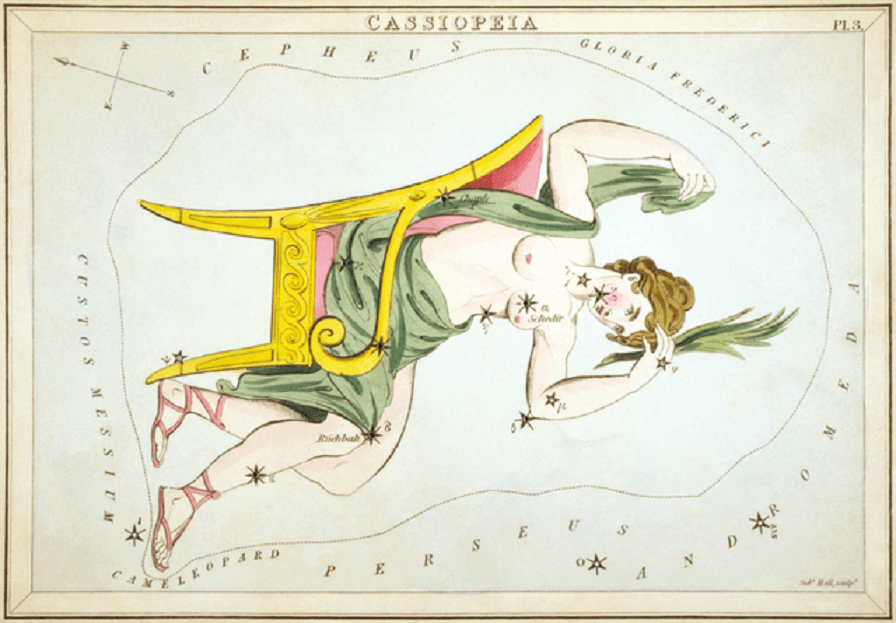
The constellation Cassiopeia is named for the Queen of Aethopia, who was the wife of Cepheus and mother of Andromeda.
In Greek mythology Cassiopeia would boast that she was more beautiful than the Nereid nymphs, a boat which of course enraged the Nereids, which then prompted Poseidon to send forth a sea monster. Cassiopeia’s daughter would be placed as a sacrifice to this sea-monster but before being killed, Andromeda was rescued by Perseus.
The constellation Cassiopeia appears near to other constellations associated with the Perseus myth, including Cepheus, Andromeda and Perseus, but the constellation Cassiopeia rotates around the North Pole, meaning that as a punishment for her hubris, Cassiopeia must spend time hanging upside down.
CENTAURUS - THE CENTAUR

The constellation Centaurus is a representation of a centaur, one of the half-men, half-horse creatures of Greek mythology.
There is discord about just which centaur Centaurus is representing, for two names are put forward, Chiron and Pholus.
Chiron is the most famous centaur in Greek mythology, an immortal son of Cronus, who would act as tutor to many famous heroes of ancient Greece, including Heracles and Asclepius. Chiron would give up his immortality when he was hit by one of Heracles’ arrows, and was placed thereafter amongst the stars, although Chiron is also associated with the constellation Sagittarius.
Pholus was another of the more civilised centaurs. Pholus was friendly towards Heracles and entertained the hero with a meal and wine. Heracles though would end up fighting the other centaurs and Pholus was killed when he was accidentally pricked by an arrow that was dipped in the poisonous blood of the Hydra.
CEPHEUS - CEPHEUS
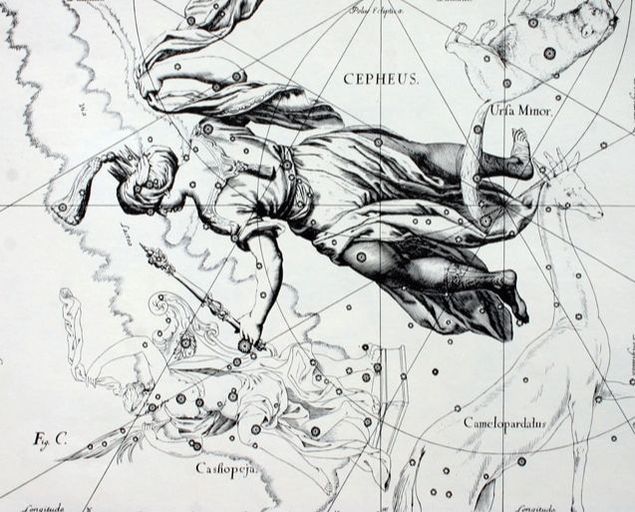
The constellation Cepheus is another constellation that represent part of the Perseus myth, for Cepheus was the king of Aethopia when Perseus came to that land.
Cepheus was the husband of Cassiopeia and the father of Andromeda, but disaster would come to Cepheus’ kingdom when his wife rashly proclaimed her own beauty, and a sea monster, Cetus, was sent to ravage the land. Cepheus would be forced to offer up his daughter Andromeda to placate the monster, but then Perseus came to rescue Andromeda and kill the sea monster.
The constellations Cepheus, Cassiopeia, Perseus, Andromeda and Cetus are neighbours in the night sky.
CETUS - THE SEA-MONSTER

In Greek mythology the name Cetus relates to a sea monster, and there were various sea monsters who appeared in ancient tales, in the case of the constellation Cetus, the sea monster it was said to represent was the Aethiopian Cetus.
The Aethiopian Cetus was the sea monster sent by Poseidon to ravage Aethiopia because of the boastful Cassiopeia, and it was to this monster that Andromeda was due to be sacrificed.
Perseus though arrived at this moment in Aethiopia, and using the head of Medusa killed Cetus and rescued Andromeda.
Cetus appears in the part of the sky where many other water constellations are found including Aquarius, the water carrier, and Capricornus, the sea-goat, which gives rise to this locale being known colloquially as “the sea”.
CORONA AUSTRALIS - THE SOUTHERN CROWN

Corona Australis is one of the least defined of Ptolemy’s 48 constellations when it comes to Greek mythology, and with a name in Greek that means Southern Wreath, or Crown, it has often been mistaken for Corona (Corona Borealis), the Crown.
At one point the constellation was known as Corona Sagittarii suggest it was the crown of the Archer, or perhaps not a crown but instead a sheaf of arrows.
More commonly though, Corona Australis is linked with the story of Dionysus, with the crown actually being a wreath made of myrtle. Having descended to, and returned from, the Underworld, having rescued his mother Semele, Dionysus would place the wreath in the stars as the constellation Corona Australis.
CORONA BOREALIS - THE CROWN
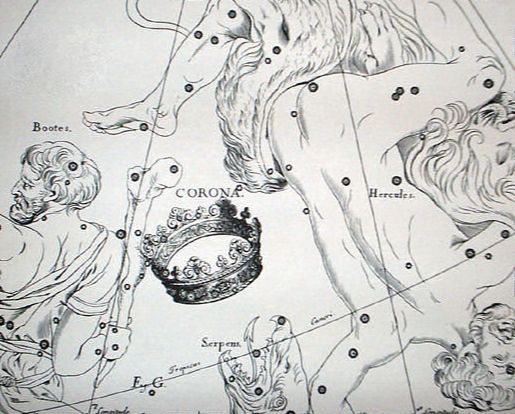
Once simply known as Corona, the Crown, the constellation is now more commonly named Corona Borealis, in order that it is not confused with Corona Australis.
Whilst occasionally referred to as the Crown of Dionysus, this crown is normally associated with Corona Australis, and so the mythology of Corona Borealis normally revolves around Ariadne, with two tales told in Greek mythology.
Some ancient writers call the Corona, the Crown of Theseus, alluding to a crown given to the Greek hero by Amphitrite as indication that Theseus was a son of Poseidon. The jewels of the crown were of such lustre that the crown allowed Theseus to navigate through the darkness of the Labyrinth as he sought out the Minotaur. Theseus would subsequently give the crown to Ariadne as a thank you for her assistance, after which it was placed amongst the stars.
Alternatively, Corona Borealis is the Crown of Ariadne, given to the daughter of King Minos by the gods, when Ariadne married the god Dionysus; and thus, Dionysus placed the crown amongst the stars.
CORVUS - THE CROW

Corvus, the Crow, is a constellation described by Ptolemy, and in Greek mythology, two tales are told about the appearance of the crow in the night sky, with both stories involving the god Apollo.
One story tells of how Apollo was in love with a mortal woman named Coronis, but having fallen pregnant by the god (with the baby being Asclepius), Coronis consorted with the mortal prince Ischys. Apollo would kill his lover, but placed her amongst the stars for Coronis’ name means crow.
A more common tale tells of Apollo ordering a crow to fetch water in a cup so that he could make a sacrifice to Zeus. The crow took the cup but tarried in his task for he waited for some figs to ripen so that he could eat them.
To hide the fact that his appetite had caused Apollo to wait, the crow told a story of how the water source was guarded by a water snake, and even went as far as catching one to make his story more believable. Apollo recognised the lie for what it was, and so the god threw the crow, the cup and the snake into the sky, where the crow became Corvus, the cup became Crater, and the snake became Hydra. As punishment, Apollo also ensured that the crow could never drink from the cup.
CRATER - THE DRINKING CUP

In the night sky, Crater is the Drinking Cup constellation, but two possibility are put forward in Greek mythology about whose drinking cup Crater is. The cup might be the cup of Pholus or the cup of Apollo, and as Crater is next to the constellations Centaurus and Corvus, both possibilities are plausible.
Pholus was a centaur who some say became Centaurus, for Pholus once welcomed Heracles to partake of food and drink with him. The smell of alcohol caused a riot amongst the other centaurs, and in the ensuring battle between the wild centaurs and Heracles Pholus was accidentally killed. Heracles thus asked for the centaur and his drinking cup to be placed amongst the stars.
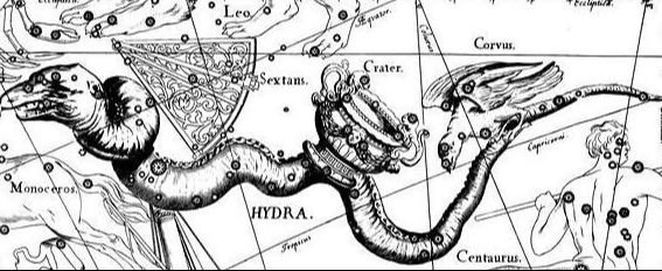
Alternatively, Crater might be the drinking cup that Corvus the crow was supposed to fill with water for the god Apollo. When Corvus took his time over the task, and then lied about an encounter with a snake, an angry Apollo placed Crow (Corvus), the cup (Crater) and the snake (Hydra) amongst the stars.
CYGNUS - THE SWAN
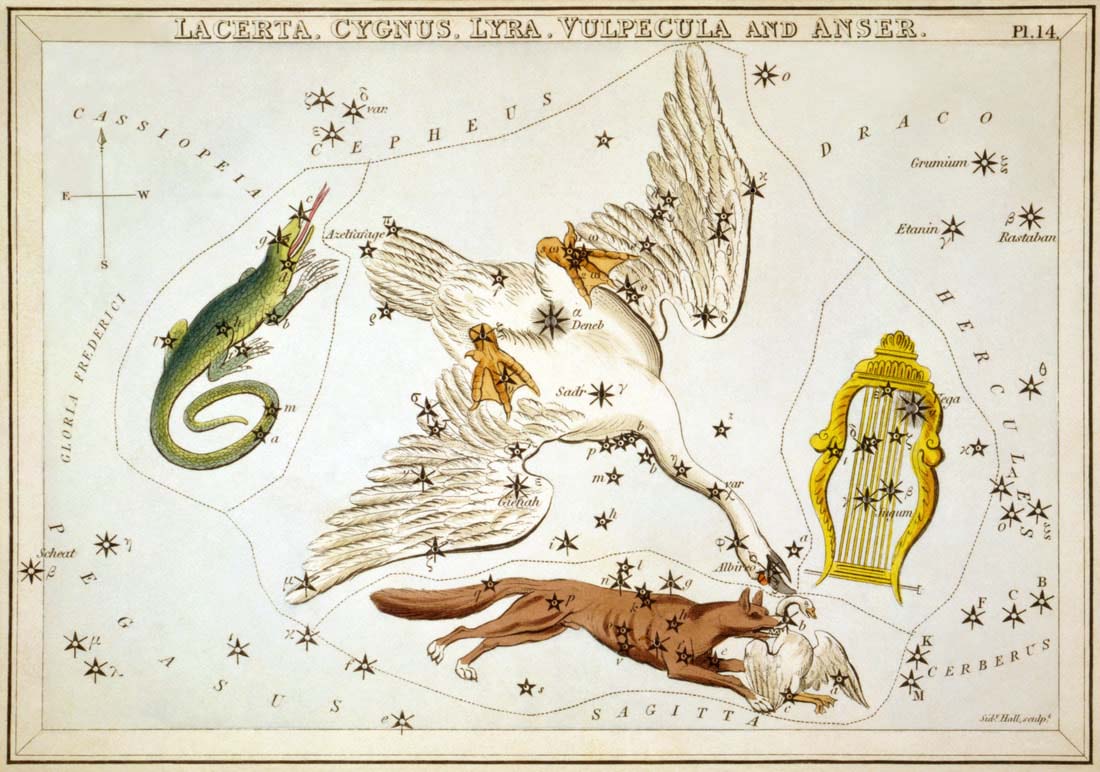
The constellation Cygnus was, according to the Ancient Greeks, a representation of the Swan, a bird which appeared in Greek mythology almost as often as the eagle.
It is most commonly said that the Swan depicted by the Cygnus constellation is that of Zeus who had disguised himself as the bird in order that he might seduce the beautiful Leda, wife of King Tyndareus of Sparta. Zeus was successful in his seduction of Leda, who subsequently gave birth to Helen and Pollox (Polydeuces), as children of Zeus, as well as Clytemnestra and Castor, as children of Tyndareus.
Zeus subsequently placed the likeness of the swan amongst the stars as Cycnus is recognition of his conquest.
The names Cygnus and Cycnus was common in Greek mythology and occasionally the constellation is said to be a representation of Cycnus, son of Ares, who was killed by Heracles, of Cycnus, son of Poseidon, who was killed by Achilles, or Cycnus, a friend of Phaethon, who mourned the death of the son of Helios.
DELPHINUS - THE DOLPHIN
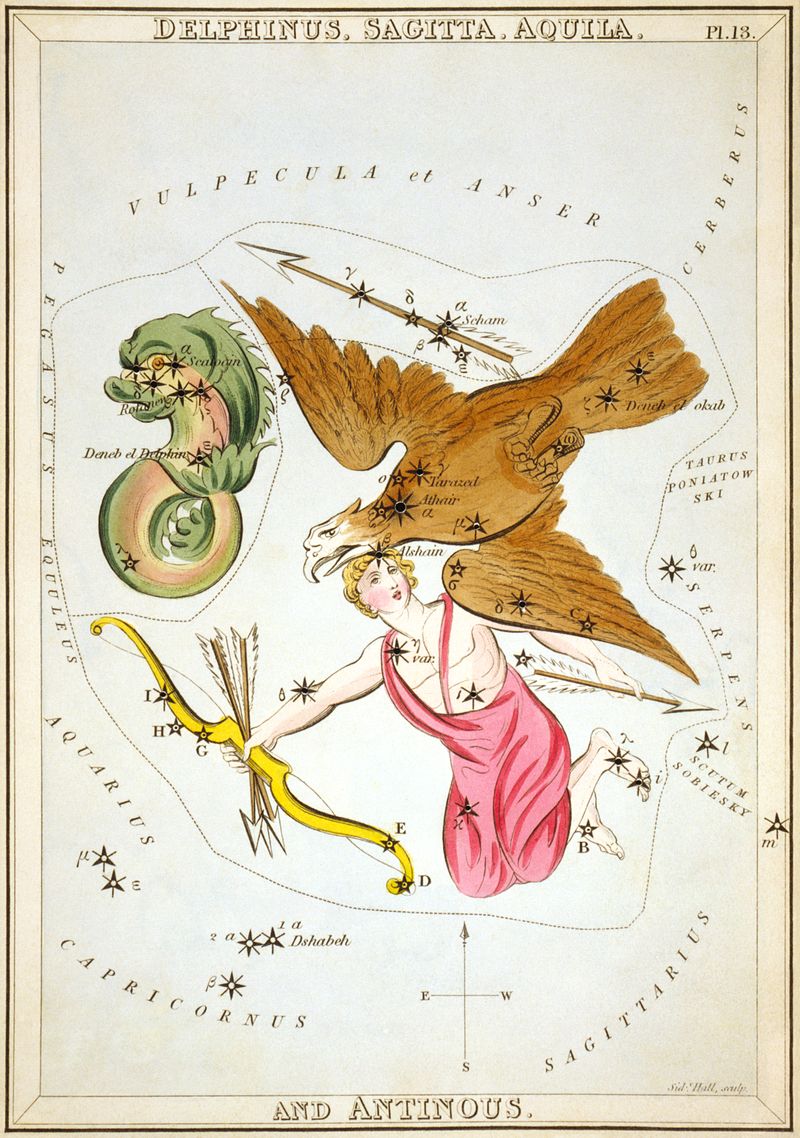
Dephinus, the Dolphin, is one of Ptolemy’s 48 constellations, and its story is most commonly associated with the sea god Poseidon.
In Greek mythology, Poseidon had decided that the Nereid Amphitrite was to be his bride, but Amphitrite was reluctant to marry the Olympian god. As a result, Amphitrite would hide herself away, avoiding those messengers of Poseidon sent to find her; eventually though, Delphin, a minor sea god, whose appearance was that of a dolphin, found her. Delphin was eloquent enough to persuade Amphitrite to agree to marry Poseidon.
Poseidon was so grateful for the efforts of Delphin that he placed the likeness of the sea god amongst the stars so that he would always be remembered.
Occasionally it was said that Delphinus was actually the representation of the dolphin which saved the poet Arion from drowning, or one of the Tyrrhenian pirates who had been transformed by Dionysus into dolphins when they had the affront to capture the god.
DRACO - THE DRAGON

The constellation Draco is said to be the representation of a Dragon from Greek mythology.
The idea of dragons and gigantic serpents were common features of Greek mythological tales, with the name dragon or serpent being used interchangeably.
The constellation Draco is most commonly said to represent Ladon, the dragon found in the Garden of Hera alongside the Hesperides. Ladon would guard the legendary Golden Apples found inside the Garden of Hera, but when Heracles had need of them for one of his labours, the Greek hero killed Ladon. It is also said by some that it was Atlas who killed Ladon, rather than Heracles, for Heracles was holding up the heavens whilst Atlas retrieved the Golden Apples.
Less commonly, the constellation Draco is named as the dragon made use of by the Gigantes during the Gigantomachy. This dragon was thrown at Athena during the war, but the goddess caught hold of it and threw it into the heavens.
There were other dragons spoken of in Greek mythology, including Kampe, the guard of Tartarus, the dragon of Ares slain by Cadmus, and Typhon, the monstrous beast who challenged the rule of Zeus.
EQUULEUS - THE HORSE

The constellation Equuleus is one of the least defined in Greek mythology, although it of course represents a small horse.
One possibly source of the constellation Equuleus in Greek mythology is the tale of Melanippe (also known as Hippe), daughter of the centaur Chiron. Melanippe was courted by Aeolus, son of Hellen, and Melanippe fell pregnant. Wishing to hide her pregnancy from her father, Melanippe hid upon Mount Pelion, but when her father came looking for her, Melanippe prayed to Artemis for help, and the goddess transformed her into a mare. Whilst in horse form, Melanippe gave birth to a daughter, Arne, who though born in foal form, was later transformed into human form.
It was Artemis who later put Melanippe’s likeness into the stars, although as she is still hiding from Chiron, the constellation Centaurus, only her head is visible.
Some say though that the constellation Equuleus is a different horse, potentially Celeris, the offspring of Pegasus, and the swift horse who was later owned by Castor.
ERIDANUS - THE RIVER

The constellation Eridanus, in Greek mythology, is the representation of a great river, a river normally said to be the Eridanus, but also named by others as the River Nile.
In the case of the constellation Eridanus being named for a river of the same name, then a look on a current map will fail to produce said river, for in Greek mythology, the Eridanus was a river believed to run through the mythical land of Hyperborea; the land beyond the North Wind.
The name Eridanus is normally translated as “early burnt”, and as a result the earthly river is associated with the story of Phaethon.
Phaethon was said to have fallen into the river after Zeus had knocked him from the sun chariot with a thunderbolt.
Subsequently, the Eridanus River was equated with both the Po and Danube.
GEMINI - THE TWINS

Gemini is one of the most famous of constellations, being also a sign of the zodiac. Gemini of course represents the “Twins”, who were most commonly named as Castor and Pollox (Castor and Polydeuces), the Dioscuri, from Greek mythology.
Castor and Pollox were twin sons of Leda, the Spartan Queen, but whilst Castor was the mortal son of Leda’s husband, Tyndareus, Pollox was the immortal son of Zeus. Noted heroes in Greek mythology, Castor and Pollox would rescue their sister Helen when she was abducted by Theseus, and would also become Argonauts. When however Castor was killed, Pollox decided to give up his own immortality, and thus the two brothers were placed amongst the stars by Zeus.
Whilst the constellation Gemini is most commonly said to represent Castor and Pollox, it was also said by some that the pair of figures were actually Apollo and Heracles, who famously wrestled when Apollo angered Heracles.
HERCULES - HERACLES

The constellation Hercules is named for the greatest of Greek heroes, Heracles. The demi-god son of Zeus and Alcmene was known for his many adventures fighting giants, monsters and men.
The Greeks called the constellation “Engonasin” the kneeler, and was generally considered to be Heracles in a kneeling position. Two different versions are given as to why Heracles is thus depicted as kneeling, either he was kneeling as he was about to give the killing blow to Ladon, the dragon-guard of the Garden of the Hesperides, or else Heracles was kneeling in exhaustion after he battled with the Ligurians.
Despite the name of the constellation the kneeling figure amongst the stars is not always said to represent Heracles for it was also said by some to represent Theseus, who was kneeling to retrieve his father’s weapons from beneath a boulder; Ixion, who was being punished by being bound to a fiery wheel in the heavens; or it was Orpheus, who was kneeling next to his lyre (the constellation Lyra).
HYDRA - THE WATER SERPENT
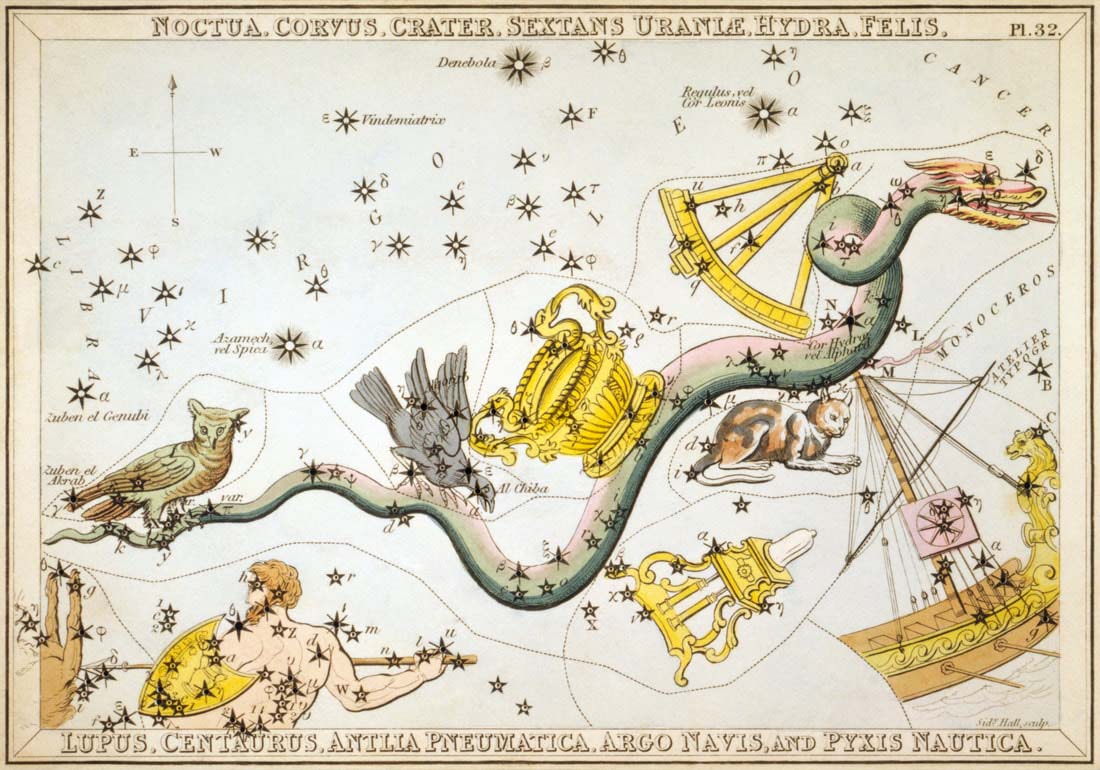
Hydra is the Water Serpent constellation and is most commonly said to represent the Lernaean Hydra from Greek mythology; the Lernaean Hydra being one of the monstrous offspring of Echidna.
The Lernaean Hydra was a multi-headed water serpent who lived in the marshes of Lerna. Heracles was tasked by Eurystheus, at Hera’s bidding, to kill the Lernaean Hydra for one of his Labours. The antipathy of Hera towards Heracles was such that she was attempting to kill her husband’s son.
Aided by Iolaus, Heracles was soon getting the better of the Lernaean Hydra, and so Hera sent Carcinus (Cancer) to aid the Water Serpent, but to no avail, and as both the Lernaean Hydra and Carcinus were killed, Hera placed the likeness of both amongst the stars in recognition of their efforts.
A less common Greek myth has the Hydra actually represent a water serpent of Apollo, whom the god placed in the stars to prevent Corvus (the crow) from drinking of Crater (the bowl).
LEO - THE LION

The constellation Leo is of course the representation of a lion, and event today the name Leo is linked inextricably with the king of the animals.
In ancient sources it almost universally agreed that the constellation Leo in Greek mythology is the representation of the Nemean Lion, another of the monstrous beasts of Greek mythology.
The Nemean Lion was a child of Orthrus and the Chimera, and was trained by the goddess Hera for the specific task of killing Heracles, the illegitimate son of her husband Zeus.
The Nemean Lion was to be found in Nemea, in the Argolis, and from its cave it would ravage the surrounding lands.
Heracles would be dispatched by Eurystheus to kill it, but the skin of the Nemean Lion was impervious to weapons, and so Heracles would eventually have to wrestle with it, before Heracles killed the beast by strangling it.
In recognition of its attempt to kill Heracles, Hera would place its likeness amongst the stars.
LEPUS - THE HARE

The constellation Lepus is the constellation also known as the Hare, but although there are tales from Greek mythology to explain the constellation’s existence, there is no agreement upon its origin, nor are the tales overly famous in Greek mythology.
The closeness of the constellation Lepus to that of Orion and his hunting dog has ensured that a connection is made between them; and so it is said by some that the hare was placed amongst the stars to ensure that Orion had something to hunt.
Others tell of the constellation Lepus being created by the messenger god Hermes to give recognition of the fertility of the animal.
Whilst others say the hare was placed amongst the stars as a warning after a pregnant hare was introduced to the Dodecanese island of Leros; the descendants of that original hare brought destruction to the island after they ate all the island’s vegetation.
LIBRA - THE SCALES
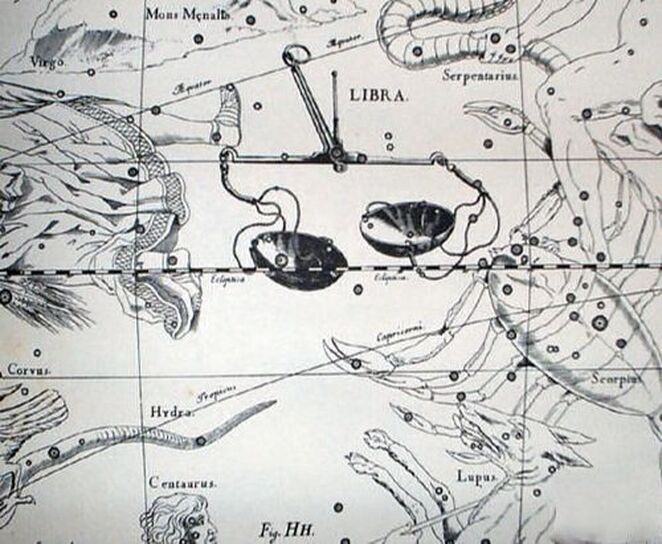
The constellation Libra is most commonly said to be representative of a set of scales, and two stories from Greek mythology are given as to why scales are to be found in the night sky.
The more common tale from Greek mythology for the existence of Libra tells of the scales being those owned by Astraea, the Greek goddess of Justice.
The scales of justice are a common emblem even today with symbolism being the weighing of evidence. The goddess Astraea is often connected with Virgo.
Some tell of the scales, Libra, being owned by a different goddess, Tyche, the Greek goddess of fortune. Tyche would often work closely with the goddess Nemesis, to ensure that man’s life was balanced between good fortune and bad.
LUPUS - THE WOLF
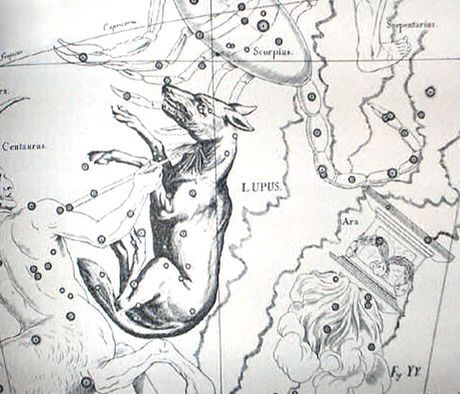
Today, the constellation Lupus is linked with the wolf, for the name was given to it when the Latin translation of Ptolemy’s original work was created.
There is no story from Greek mythology to connect the wolf with the constellation Lupus though, and prior to Ptolomy the constellation of stars was said to be just an unidentified animal that had been impaled by Centaurus.
LYRA - THE LYRE

Lyra, the Lyre, is a constellation said to represent the Lyre of Orpheus. The lyre was originally invented by the new-born Hermes, making use of a tortoise shell. Apollo then exchanged cattle for this new musical instrument, and Apollo would later present this lyre to Orpheus.
Orpheus was a legendary musician with heroic characteristics, for it was said that Orpheus was one of the Argonauts. During the quest of the Argonauts, Orpheus was said to have used the lyre to overcome the sound of the Sirens. Later, would travel to the Underworld in a failed attempt to retrieve his deceased wife, Eurydice.
After the death of Orpheus, his lyre was then said to have been placed amongst the stars by Zeus, as the constellation Lyra.
Others, in Greek mythology, did make use of the lyre, and occasionally it is said that the lyre in the night sky belonged to one of these people, potentially Theseus, or Thamyris, the bard who foolishly challenged the Muses.
OPHIUCHUS – THE SERPENT BEARER
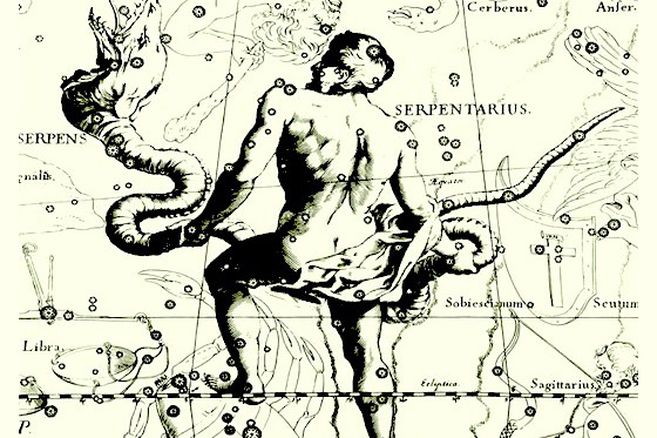
The constellation Ophiuchus is normally depicted as a man holding on to a snake, there is though little agreement about who the man, in Greek mythology, is.
The theme of man and god wrestling with snakes was a common one in the tales of Greek mythology. Thus, it could be that Ophiuchus represents the Greek god Apollo and his struggle with the Python, the monstrous serpentine offspring of Gaia.
Alternatively, Ophiuchus might be a recognition for some positive achievement, so perhaps the constellation represents Heracles, for the demi-god had once slayed a giant serpent in Lydia, or Phorbas, who had rid the island for Rhodes of snakes. The Greek god of medicine, Asclepius was also connected with snakes, for a snake wrapped around his rod was his symbol.
The setting of a man with snake in the night sky could also be seen as a warning, and some tell of Ophiuchus being Laocoon, the priest of Troy who was strangled by sea serpents when his was set to reveal the secret of the Trojan Horse.
Or else it was said to be Triopas, a king who destroyed a temple of Demeter to build his own house, or it was King Carnobon who killed one of the serpent who pulled the chariot of Triptolemus, and thus Carnobon too was punished by Demeter.
ORION - ORION
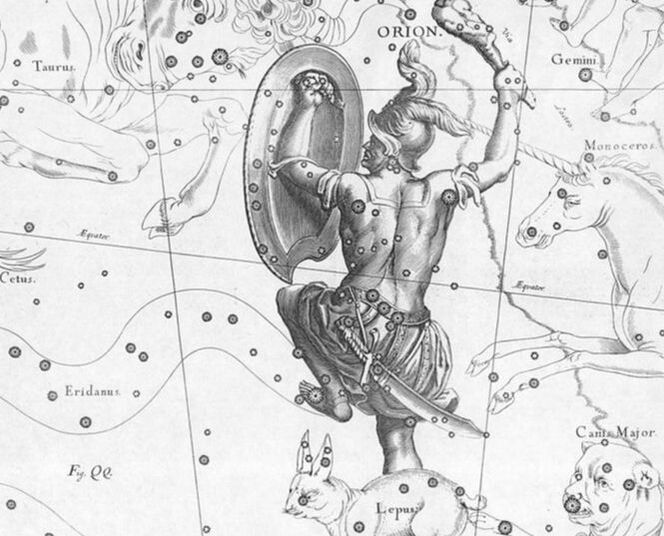
The constellation Orion is said to represent the great hunter Orion, a legendary hunter of Greek mythology.
A giant son of Poseidon and Euryale, Orion would become a companion of Artemis, and the two would often hunt together. Being a master of the hunt though, would prove to be downfall of Orion, for he would die at the hands of either Gaia or Artemis.
Most commonly it was said that Gaia sent forth a giant scorpion to kill Orion, after the hunter had said that he would kill all of the animals found on the earth.
Artemis would have his likeness placed amongst the stars, where he was joined by a hunting dog, the constellation Canis. Also in the night sky though, is the likeness of the scorpion that had killed him, the constellation Scorpius, and even now, as Scorpius appears over the horizon, Orion disappears.
PEGASUS - PEGASUS
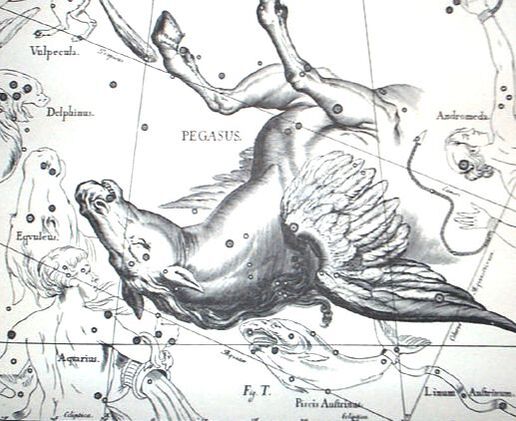
Pegasus is a legendary winged horse in the tales of Greek mythology, and so it is the creature most commonly associated with the constellation Pegasus.
The constellation though is also named as Equus or Hippos, Latin and Greek for horse, and so some also tell of the constellation being a representation of Melanippe, daughter of Chiron.
Of the two, Pegasus and Melanippe, Pegasus is of course the more famous, for the winged horse was the offspring of Poseidon and the Gorgon Medusa, who was famously used by the Corinthian hero Bellerophon as he killed the Chimera. Pegasus though was also used by Zeus to transport his weapons, and so his likeness amongst the stars was done by the supreme god.
Melanippe was the daughter of the civilised centaur Chiron. Melanippe would become pregnant by Aeolus, but fearing her father’s reaction, Melanippe would hide herself away in the forests of Mount Pelion. Chiron though sought out his daughter, and when he came near, Melanippe prayed to the gods that he might not find her, and thus she was transformed into a mare. Even in the night sky, when the constellation of Chiron appears, so Pegasus disappears.
Alternatively, the transformation of Melanippe was a punishment from the gods, for she had revealed too many of their secrets to men.
PISCES
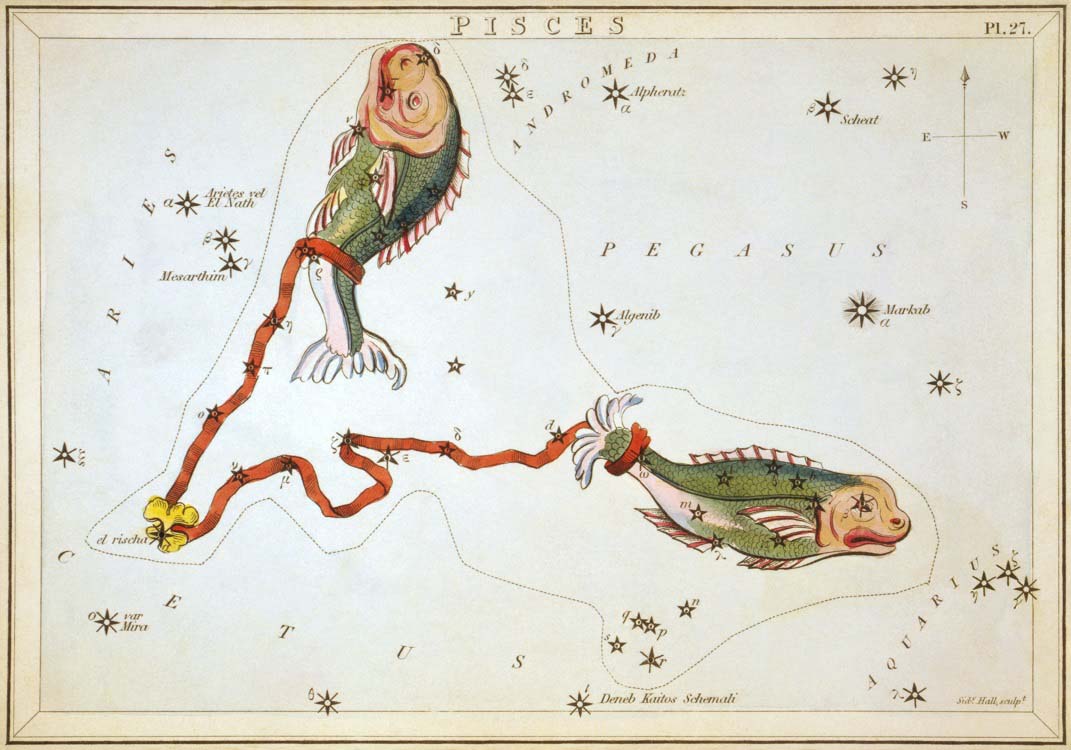
After the Olympian gods had defeated the Titans and the Giants, Gaia, or Mother Earth, coupled with Tartarus, the region of the Underworld where Zeus held the Titans imprisoned, and they had Typhon, the scariest monster the world had ever seen. Typhon had a hundred dragon’s heads, with fire blazing from all his eyes. Gaia sent Typhon to defeat the gods. Pan was the first to see him coming.
He alerted the other gods and then transformed himself into a goat-fish and jumped into the river Euphrates to escape the monster. The goat-fish is represented by the constellation Capricornus.
The goddess Aphrodite and her son Eros called to the water nymphs for help and jumped into the river. In one version of the legend, two fishes came to the rescue and carried Aphrodite and Eros on their backs to safety. In another version, the mother and son were themselves transformed into fish.
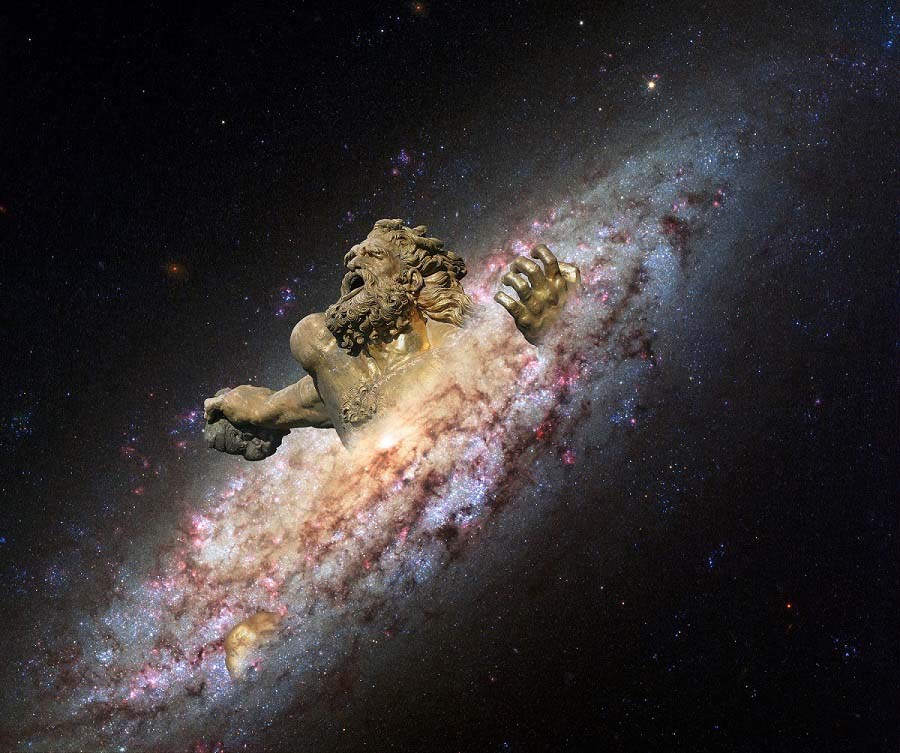
THE MILKY WAY IN GREEK MYTHOLOGY

HERACLES AND HERA VERSION
The story begins in Thebes, where Alcmene had become pregnant by the god Zeus. An indignant Hera then did her best to prevent the birth of her husband's illegitimate son, and the goddess ordered Ilithyia, the Greek goddess of childbirth, was ordered not to allow Alcmene to give birth.
Whilst Hera was absent organising the succession of Eurystheus to the throne of Mycenae, Ilithyia was tricked into allowing Alcmene to give birth, and so came forth two sons on successive days, Alcides, the son of Zeus, and then Iphicles, the son of Amphitryon.
Almene and Amphitryon recognised that Hera was angry with them, and so Alcides would be renamed Heracles, meaning “for the glory of Hera”, to attempt to appease the goddess.
Alcmene and Amphitryon still feared what an angry Hera might do in retribution for Zeus' actions, and so to save Iphicles, Alcmene made the difficult decision that Heracles must be exposed in a Theban field.
Exposure was a common method of killing unwanted children in Ancient Greece, for if the child died then it must have been the will of the gods. This leads to many cases of exposure in Greek mythology, but of course these children commonly survive, for it was the will of the gods that they did, with stories of Oedipus, as well as Amphion and Zethus being examples.
Of course it was the will of Zeus, that his son survive but it was the goddess Athena who intervened upon her half-brother's behalf.
Athena observed the abandonment of Heracles in the Theban field, and descending from Mount Olympus, took up the new born baby, and returned with him to Mount Olympus.
The mischievous side of Athena then came through, for she went to Hera, to tell of her rescuing this unknown baby; Athena of course knowing full well who she had rescued.
The motherly instincts of Hera kicked in when she saw the baby, and taking the boy from Athena, started to nurse him.
Heracles would happily suckle upon the nipple of Hera, but as he did so, he sucked too hard, and in pain, Hera removed the baby from her nipple. As Hera did so, the motherly milk of Hera sprayed out into the heavens, creating the Milky Way.
Heracles was revitalised by the nourishment he had received, and Athena then returned the baby back to Alcmene and Amphitryon; and the parents of Heracles now realised that it was the god's will that he should grow up with them.
(Hyginus 2.43.)
RHEA VERSION
When the Titaness Rhea presented a stone wrapped in swaddling cloth to Cronus as substitute for the infant Zeus, the Titan pressed it against her breast and milk flowed forth which flowed formed the Milky Way.
(Hyginus 2.43.)

Our Mobile Application
Check out Our Mobile Application "Ancient Greece Reloaded"
